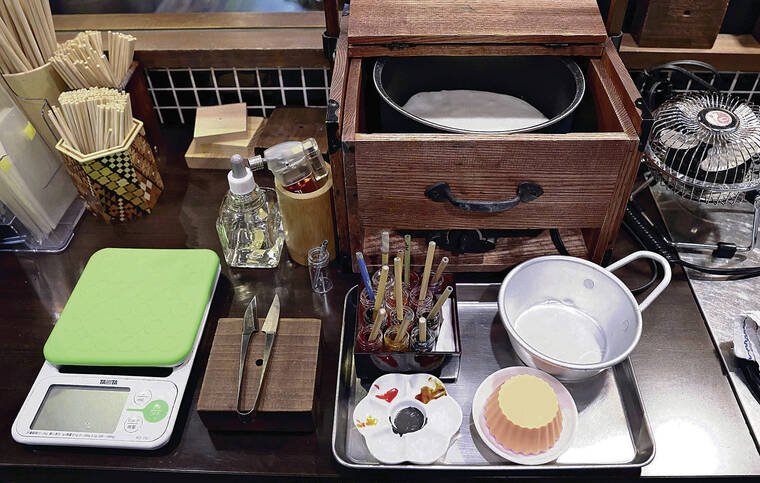Beautiful, elaborate amezaiku sweets soothe the soul

THE YOMIURI SHIMBUN
Amezaiku Yoshihara sells about 100 kinds of amezaiku products, such as the Pegasus, poodle and parakeet shown above.

YOMIURI SHIMBUN
Amezaiku artists use these tools to create candy creatures. Amezaiku Yoshihara sells about 100 kinds of amezaiku products.


TOKYO >> Rabbits holding flowers, poodles with collars and parakeets in bright colors — all perched on sticks — greet me with a sweet aroma as I enter a candy shop in Tokyo.
Leaning in for a closer look, I was surprised by how detailed the sweets were and felt soothed by their cuteness.
Amezaiku Yoshihara in the Sendagi area of Tokyo is a shop that sells amezaiku, artistic candy made using a traditional technique dating back to the Edo period (1603-1867). At the shop, customers can watch craftsmen make beautiful edible pieces for purchase.
Takahiro Yoshihara, 48, chief artist and president of Amezaiku Yoshihara, allowed me to watch him make an amezaiku Pegasus. First, he heated a lump of candy in a pot to around 80 degrees Celsius. Once the candy became pliable, he added edible blue dye and kneaded them together. He then aerated the candy to give it a smooth texture, rolled it into a ball and stuck it onto the end of a stick.
Then, he started forming the Pegasus. He made a couple of snips into the lump and stretched it using his fingers. Immediately, the wings and legs were formed. After the mane and tail were shaped using scissors, the Pegasus looked as if it could fly off the stick.
The whole process took only three minutes and smelled faintly of vanilla. Everything has to be done quickly before the candy cools and hardens.
Don't miss out on what's happening!
Stay in touch with breaking news, as it happens, conveniently in your email inbox. It's FREE!
Among nonedible items displayed in the shop such as old journals and essays written by a traveler, there was a picture of a craftsman with a topknot inflating a piece of candy in front of a child. According to Yoshihara, who also studies history, amezaiku artists have been around since the middle of the Edo period and sold their products in town.
Since many of the amezaiku products were shaped like birds, they were originally called Ame no Tori, meaning candy bird. Since the word ame can mean rain as well as candy in Japanese, it is said that amezaiku artists used umbrellas as their emblem.
In the Showa era (1926-1989), amezaiku artists operated near schools and at festivals, but today, there are only about 30 professionals nationwide.
Yoshihara was among the children who grew up seeing amezaiku at festivals and became fascinated by the skill. He started training under a master at 26 and learned the techniques. He opened his shop in 2008, and now, he said many foreign tourists visit his shop and locals buy amezaiku products as wedding or baby gifts.
“Documents related to amezaiku usually show smiling children of all ages,” Yoshihara said. “While the candy melts and disappears, the memories remain.”



